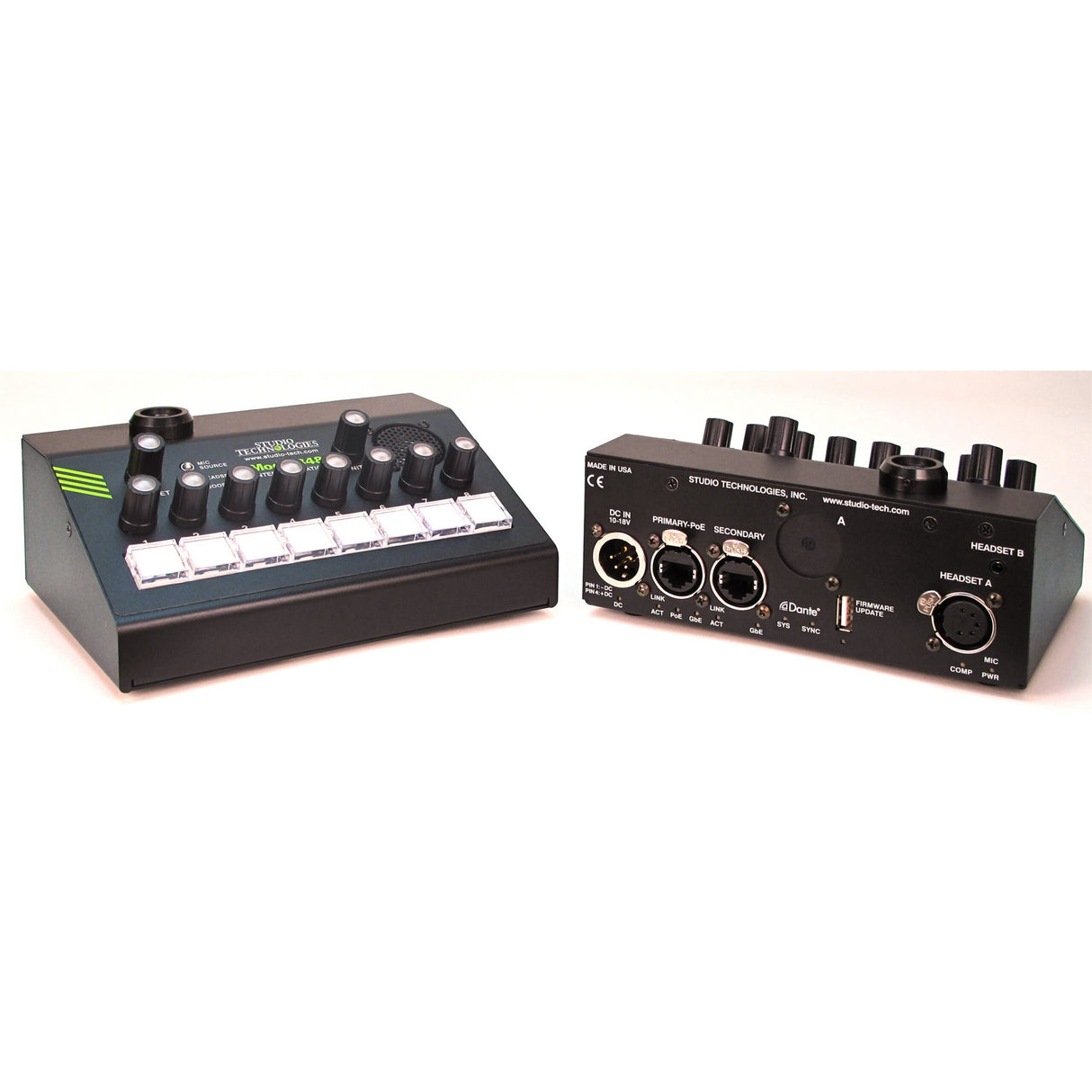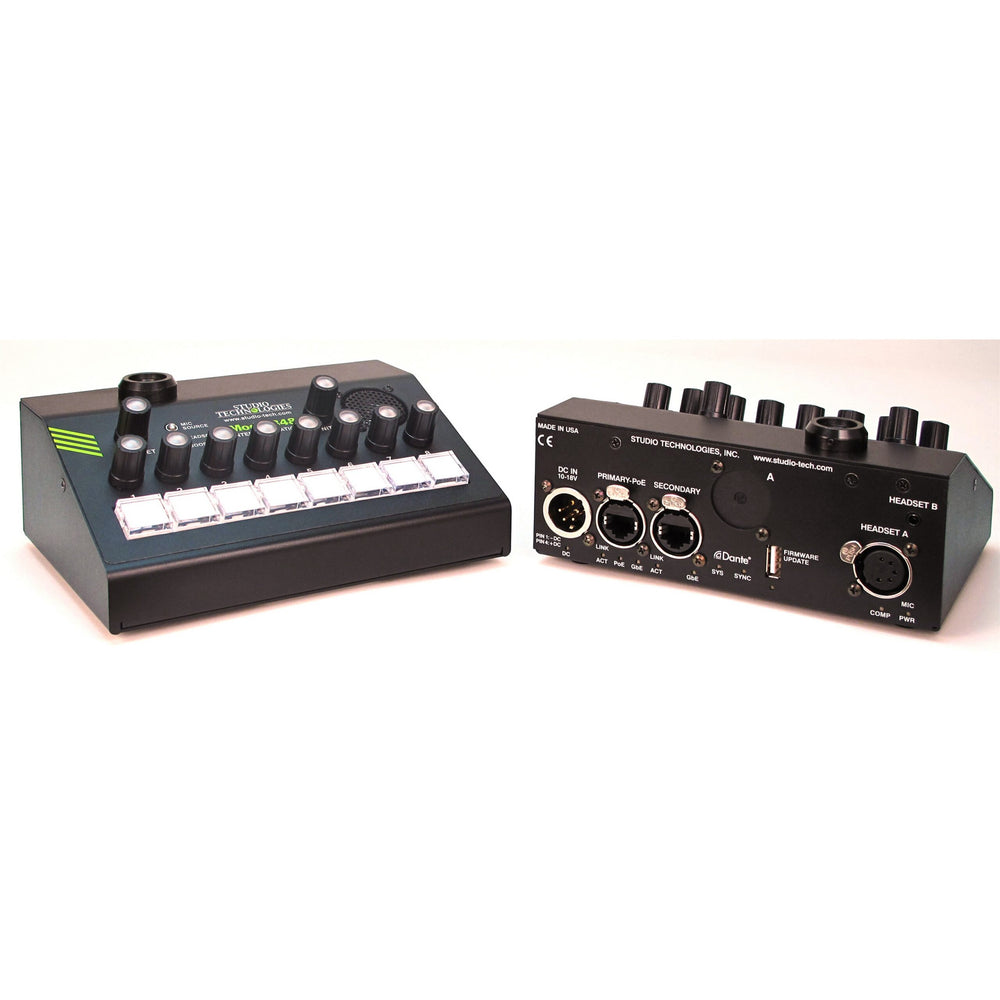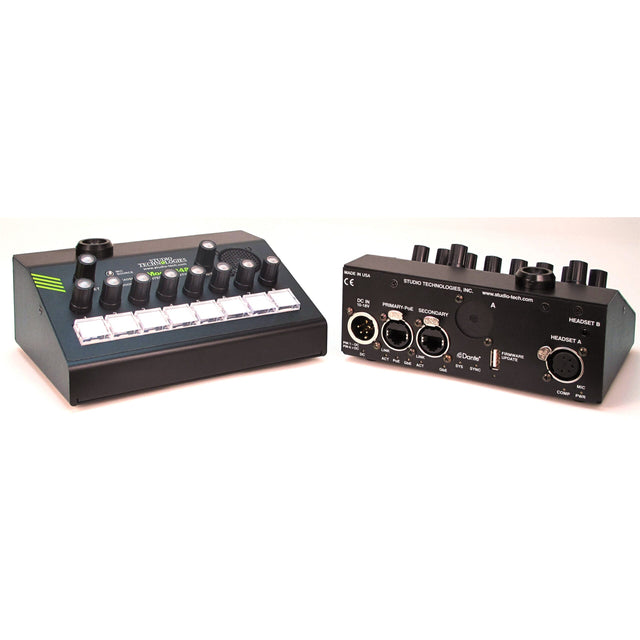Free Shipping
Pickup later: Pickup available after order processing
More finance options:
Estimated Shipping Widget will be displayed here!
Condition: New
Description
Studio Technologies Model 348 Intercom Station
The Model 348 Intercom Station provides eight independent talk and listen channels that are compatible with Dante audio-over-Ethernet networks. The desktop unit is designed to serve as an audio control center for production and support personnel in numerous applications including on-air television sports and news broadcasting, live events, theater, industrial, and corporate AV. The Model 348's channels can be part of virtual “party-lines” created with other compatible devices or be used directly in point-to-point intercom implementations. The range of resources makes It'simple to use the Model 348 locally, or as part of a REMI or “At-Home” geographically diverse implementation. In addition to intercom applications, the unit can create multiple independent IFB (talent cue) channels. Other applications may benefit from the Model 348 user's ability to easily create monitor mixes from the eight input audio channels. This makes the unit a viable choice for listen-only scenarios.
Key Features
- Dante audio-over-Ethernet technology
- Excellent audio quality
- Eight independent talk and listen channels
- 5-pin female XLR headset connector
- 3.5 mm 4-conductor TRRS headset connector
- 1/4” gooseneck microphone connector
- Built-in speaker
- IFB talent cueing functions
- Call send and receive functions
- Uses STcontroller for configuration
- Redundant Ethernet connections
- PoE and 12 Vdc powering
Technical Specifications
Applications
Dante-based intercom, IFB (interrupted foldback) master station, audio
monitor mixer, specialized tone generator
Power Sources
Power-over-Ethernet (PoE)
Class 0 (classification unimplemented, =12.94 watts) per IEEEr 802.3af
External
10 to 18 volts DC, 0.65 A maximum at 10 volts DC (can be powered by optional PS-DC-02)
Network Audio Technology
Type
Dante audio-over-Ethernet
AES67-2013 Support
Yes, selectable on/off
Dante Domain Manager (DDM) Support
Yes
Ethernet Interface Configuration
Switched or Redundant
Bit Depth
16, 24, or 32
Sample Rate
48 kHz
Dante Receiver (Input) Channels
16
Dante Transmitter (Output) Channels
11
Dante Audio Flows
32; 16 transmitter, 16 receiver
Internal Digital Audio Processing
32-bit, fixed
Input-to-Output Audio Processing Latency
<200 uSec
Nominal Input and Output Level
-20 dBFS
Network Interfaces
2, Primary-PoE and Secondary
Type
1000BASE-T (Gigabit Ethernet (“GigE”) per IEEE 802.3ab (10 and 100 Mb/s not supported)
Power-over-Ethernet (PoE)
Per IEEE 802.3af (applicable to Primary-PoE network only)
Microphone Input - Headset
Compatibility - Headset A
Single- or dual-ear broadcast-style with dynamic or electret (low-voltage
DC-powered) microphone
Pin 1 mic common; pin 2 mic; pin 3 phones common; pin 4 phones left; pin 5
phones right
Compatibility - Headset B
CTIAT/AHJ configuration (typically uses electret powered mic): tip phones
left; ring 1 phones right; ring 2 common; sleeve mic
Type
Unbalanced
Impedance
1 k ohms, nominal, microphone power off; 690 ohms, nominal, microphone power on
Gain
26, 32, 38, 44, 50 dB, selectable
Frequency Response
-4 dB at 30 Hz, -2.6 dB at 40 Hz, -1.8 dB at 50 Hz, -2.4 dB at 10 kHz, -3.8 dB at 20 kHz
Distortion (THD+N)
<0.09%, measured at -20 dBFS, 22 Hz to 22 kHz bandwidth, 38 dB of gain
Dynamic Range
>93 dB, A-weighted, 26 dB gain
Microphone Input - Gooseneck
Compatibility
Studio Technologies' GME-3-12
Microphone Power
5 volts DC via 4.99 k resistor
Impedance
3.3 k ohms, nominal
Gain
12, 18, 24, 30, 36 dB, selectable
Frequency Response
-3.0 dB at 40 Hz, -2.0 dB at 50 Hz, -2.0 dB at 16 kHz, -3.0 dB at 20 kHz
Distortion (THD+N)
<0.04%, measured at -20 dBFS, 22 Hz to 22 kHz bandwidth, 36 dB of gain
Dynamic Range
>97 dB, A-weighted, 12 dB gain
Compressor
Application
Applies to headset and gooseneck microphone audio
Threshold
1 dB above nominal Dante output level (-19 dBFS)
Slope
2:1
Status LED
Compressor active
Headset Headphone Output
Type
2-channel (stereo)
Compatibility
Intended for connection to stereo (dual-channel) or monaural (single-channel) headsets with a nominal impedance of 50 ohms or greater
Maximum Output Voltage
3.0 Vrms, 1 kHz, 150-ohm load
Frequency Response
20 Hz to 20 kHz, +0/-1 dB
Distortion (THD+N)
<0.02%
Dynamic Range
>93 dB
Speaker Monitor Output
Type
Single-channel (monaural)
Speaker
1.3-inch (32 mm) diameter
Maximum Power
4 watts RMS, nominal
Frequency Response
150 Hz to 20 kHz, ±3 dB
18 kHz and 20 kHz Tone Outputs
Type
Sine wave
Level
-20 dBFS
Frequency Accuracy
<10 ppm
Distortion
<0.0001%
Call Function
Receive Frequency
20 kHz, ±800 Hz, within audio channel
Receive Level
-27 dBFS minimum
Send Frequency
20 kHz
Send Level
-20 dBFS
Audible Alert
3-burst sequence, 524 Hz, sine wave, selectable level range
Connectors
Headset A
5-pin female XLR
Headset B
3.5 mm 4-conductor TRRS jack, per Japanese standard JEITA/EIAJ RC-5325A
Gooseneck Microphone
inch 3-conductor with 7/16-20 UNF threaded bushing; 4-40 hex head socket set screw allows microphone to be secured into bushing
Ethernet
Neutrik NE8FBH etherCON RJ45 receptacles
External DC
4-pin male XLR (pin 1 negative, pin 4 positive)
USB
Type A recept








